SALMON FISHING
BACK TO TABLE OF CONTENTS
While trout fishing is available all year round in most places, salmon fishing is a different matter. Their migratory habits mean that salmon are not available to the fly fisherman for a large part of the year. You have to wait for them to answer their reproductive call, when they will approach their home waters and come within fishing range. The only exception to this rule are the salmon species that live permanently in the Great Lakes and other land locked waters where they have become indigenous. Of course, it is possible to catch salmon while they are at sea but that does not fall within the definition of fly fishing. The season for salmon fishing varies according to the water you are fishing and ranges from February to November. Some seasons will be very short, just a few weeks while the migrating fish pass up the river on their way to spawn.
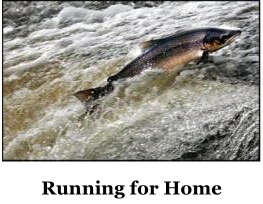 There are two quite different classes of salmon - the Pacific variety that spawn once and die and the Atlantic variety that will spawn and return to the sea, perhaps as many as seven times throughout their lives. Quite why there is this fundamental difference between the two varieties is unknown. It may have something to do with the Gulf Stream - otherwise known as the North Atlantic Drift - which keeps the North Atlantic seaboard slightly warmer in winter than it would otherwise be. This keeps the area ice free, facilitating the return to the ocean of salmon which have spawned. On the other hand the north Pacific and its rivers may freeze over for a large part of winter. This creates a much harsher environment for large shoals of fish to survive in and the frozen rivers effectively preclude any substantial food source production. It is ecologically more efficient for this harsh time to be spent as an egg rather than as a fish trying to find a meal, so there are no salmon near the North American rivers after the spawning season - they all die.
There are two quite different classes of salmon - the Pacific variety that spawn once and die and the Atlantic variety that will spawn and return to the sea, perhaps as many as seven times throughout their lives. Quite why there is this fundamental difference between the two varieties is unknown. It may have something to do with the Gulf Stream - otherwise known as the North Atlantic Drift - which keeps the North Atlantic seaboard slightly warmer in winter than it would otherwise be. This keeps the area ice free, facilitating the return to the ocean of salmon which have spawned. On the other hand the north Pacific and its rivers may freeze over for a large part of winter. This creates a much harsher environment for large shoals of fish to survive in and the frozen rivers effectively preclude any substantial food source production. It is ecologically more efficient for this harsh time to be spent as an egg rather than as a fish trying to find a meal, so there are no salmon near the North American rivers after the spawning season - they all die.
While the life of the salmon, including their technical descriptions, is detailed elsewhere it is interesting to note the number of non-technical names that have been created to encompass the different times in the life of a salmon. Some of these names are generic, occurring almost universally, while some are quite local and yet others will only apply to European salmon varieties that may spawn more than once. For example, a young salmon still in the river is known as a pink, penk, mort, samlet, salmonet, skegger, smout, smowt, smolt or sprod. On its first return from the sea it is a grilse, peal or peel and once it has spawned it is a kelt, or if it is a male who has mated then it is sometimes known as a kipper. You may know even more names!
Because they spend most of their lives at sea, where they feed on a high protein diet of fry and crustacea, salmon tend to be larger than trout. Indeed, the largest known king salmon - also known as chinook - is in excess of 120lb, with an average weight of 20lb. This demands a much heavier equipment set-up than for trout and different fishing techniques come into play. This heavier gear is epitomised by the use of the double handed rod which requires different casting methods and these are described in the Casting Section.
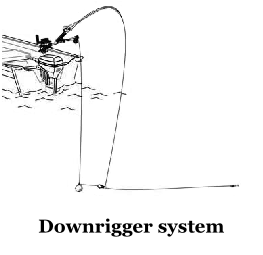 Salmon can also be caught at depth in coastal waters, in the Great Lakes and other waters where they are indigenous. This can mean fishing as deep as 100 feet or more and requires the use of specialised equipment. This may involve the use of a boat equipped with a downrigger, which is a very heavy weight that is lowered into the water on a wire. This wire is attached to a winch, either electrical or manual, that raises and lowers the weight as needed. Your leader and fly is attached to the weight by means of a quick release clip and goes down to the depths with the weight. While your fly is being taken down you pay out line from your reel to keep the whole set-up taught with the rod bent and under pressure.
Salmon can also be caught at depth in coastal waters, in the Great Lakes and other waters where they are indigenous. This can mean fishing as deep as 100 feet or more and requires the use of specialised equipment. This may involve the use of a boat equipped with a downrigger, which is a very heavy weight that is lowered into the water on a wire. This wire is attached to a winch, either electrical or manual, that raises and lowers the weight as needed. Your leader and fly is attached to the weight by means of a quick release clip and goes down to the depths with the weight. While your fly is being taken down you pay out line from your reel to keep the whole set-up taught with the rod bent and under pressure.
A fly line is not used in this method, a heavy monofilament or braided line is employed instead. Consequently this method is not really fly fishing as we know it but a general idea of the method is worth mentioning as it may be the only way you can approach your prey if you are not fortunate enough to be able to get to a salmon river when they are running.
The idea is that you cruise slowly along pulling the weight and attached gear behind the boat, in the same way as trolling. Often a long double curved plate, called a flasher, is attached to the leader between the downrigger weight and the fly. The S shaped curve in this plate causes the flasher to snake through the water and this movement is transferred to the fly giving it more action. The theory is that the salmon eventually takes the fly, which pulls the leader from the quick release clip. The rod, having been bent and under tension, springs up when the fly is taken, and the line parts company with the downrigger weight setting the hook. This gives the fisherman direct contact with the fish for the fight, unhindered by the heavy weight and wire, which is quickly retrieved to avoid fouling the line.
While the lure used is called a fly, it does not really fit the description of a fly as we know it. It looks more like a plastic squid about five or six inches long and its tentacles are very pliable permitting a lot of movement in the fly. As mentioned above, this method does not involve the use of a fly line or casting so really does not qualify as fly fishing. Nevertheless, it can be great sport if you get the chance to try it. Indeed, for large parts of the year this will be the only form of salmon fishing available to the sportsman.
As the salmon congregate prior to running into the river, it is possible to catch them in the estuarine approaches to their home water. This is usually done by trolling a bait or lure and again does not really qualify as fly fishing and so falls outside of the methods we wish to employ. Many good fish are taken in the Pacific Northwest by this method as they congregate prior to their run into the river system but we have to wait until the fish have entered the river system before they become game for the fly fisherman's rod.
The strange thing is that salmon cease to feed once they have started up the river on their spawning run. Indeed their throat actually closes and, due to the change from sea water to fresh water, they undergo physical changes that prevent them from digesting food, so there can be no doubt that they stop feeding. This would seem to create a contradiction. Why would they take a fly if they have no way of swallowing or digesting it? It remains a wonder that salmon will take a fly when they have no ability to feed.
There are as many potential explanations for this phenomenon as there are salmon fishermen! Some say that their innate feeding instinct continues even after they have become physically unable to take food. Others say that it has to do with the fish's naturally aggressive instincts. Yet others say that it is the salmon's territorial nature makes it attack a perceived interloper. No one knows for sure, but all are grateful that they do take a fly!
Salmon fishing in The British Isles has become the pastime of the wealthy - some beats (river areas where salmon tend to hold during their run upstream) can command huge prices at the right time of year. Doubtless there are some lucky anglers who have managed to gain access to good fishing for little outlay, but they are few and far between. It is also true to say that the salmon runs are neither as prolific nor as certain as they once were in Britain. This may be as a result of commercial fishing activities around the river mouths, global warming may be altering the ecology and environment in which the fish live, or other factors, such as the proliferation of sea lice caused by fish farms. These are all possible reasons for this decline but whatever the reason, I eventually found it cheaper and more certain to fly to Alaska and British Columbia to fish for salmon than try to afford a Scottish fishing holiday! And in most years you are virtually guaranteed great sport. An alternative venue that has emerged in recent years is Russia which offers the opportunity of huge runs of Atlantic salmon in unspoilt waters.
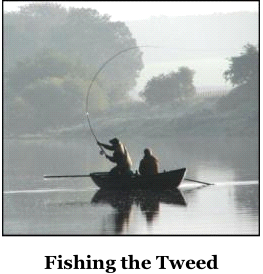 Having said all that, if you can afford the Scottish salmon experience then it is sure to create memories that you will treasure for life. Each beat on the famous Scottish rivers like the Tay and the Spey have their own name and each beat has its own named pools and even named rocks. To get the best results requires a good ghillie, patience and a lot of luck. A ghillie is the guide who accompanies you on your fishing expedition, advising on techniques, equipment, location and lots more - often with friendly insults as well as flattery and expertise. But no matter how good your ghillie is, you are still dependent on Mother Nature. It can be very frustrating to book a beat for a week only to find that the rains have created a river in full spate (flood) which is virtually unfishable. But if you are in the right place at the right time and the salmon god smiles upon you then you may be rewarded with the take, fight and trophy of a lifetime.
Having said all that, if you can afford the Scottish salmon experience then it is sure to create memories that you will treasure for life. Each beat on the famous Scottish rivers like the Tay and the Spey have their own name and each beat has its own named pools and even named rocks. To get the best results requires a good ghillie, patience and a lot of luck. A ghillie is the guide who accompanies you on your fishing expedition, advising on techniques, equipment, location and lots more - often with friendly insults as well as flattery and expertise. But no matter how good your ghillie is, you are still dependent on Mother Nature. It can be very frustrating to book a beat for a week only to find that the rains have created a river in full spate (flood) which is virtually unfishable. But if you are in the right place at the right time and the salmon god smiles upon you then you may be rewarded with the take, fight and trophy of a lifetime.
There are as many salmon flies as there are beats and pools to fish them in. Some ghillies will tell you that only their fly will work while others will gainsay that, telling you they have the perfect answer. It's all part of the game! Streamers, Waddingtons, tubes, dries, wets - the list is endless. The only advice is to go with the local lore. There is always a kernel of truth in what they say!
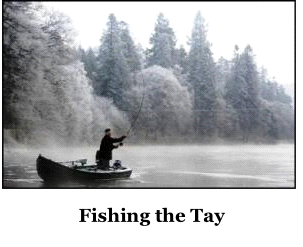 Salmon will shoal up at the entrance to their home river and wait for the conditions to be right before starting their run upstream and the biggest problem is knowing exactly when that will be. The salmon's timing has to be perfect. Too little water in the river and they will be unable to negotiate the shallower parts of the river. Too much and the force of the water will exhaust them in their attempts to swim against the current. In addition, too much flow will wash their eggs away as they spawn and before they have had time to cover their redd with gravel and stones. The ideal time is just after a rain storm in the higher reaches of the river, which will refresh and fill the river and is known as a spate. As the river slowly empties again the fish will make their run for home. With this flush of water they will move up the river, usually at night. They will rest up during the day in deep pools and behind obstacles like large rocks that give them respite from the current. This is where the fisherman will hunt for them.
Salmon will shoal up at the entrance to their home river and wait for the conditions to be right before starting their run upstream and the biggest problem is knowing exactly when that will be. The salmon's timing has to be perfect. Too little water in the river and they will be unable to negotiate the shallower parts of the river. Too much and the force of the water will exhaust them in their attempts to swim against the current. In addition, too much flow will wash their eggs away as they spawn and before they have had time to cover their redd with gravel and stones. The ideal time is just after a rain storm in the higher reaches of the river, which will refresh and fill the river and is known as a spate. As the river slowly empties again the fish will make their run for home. With this flush of water they will move up the river, usually at night. They will rest up during the day in deep pools and behind obstacles like large rocks that give them respite from the current. This is where the fisherman will hunt for them.
How to catch them? While the river is in spate it is likely to be coloured and visibility will be limited. A large garish fly is used to give maximum opportunity for the salmon to spot it. As the water level subsides so the fly size and colour reduces. Many flies resemble the shrimp that the salmon have enjoyed as a staple diet during their sojourn at sea. The General Practitioner and Ally's Shrimp are two such examples. Larger flies will be tied as a tube or Waddington and most flies are tied with a double or treble hook to ensure a good hold in the salmon's bony mouth.
Starting at the furthest point upstream - the top of your beat - the idea is to search all those holding places by casting across stream and holding the fly as it works down and finally across the current. Bearing in mind the salmon's inability to eat, it may be necessary to cover your prey (pass the fly in front of the fish) a number of times before inducing it to take the fly. But since you frequently can't see if a fish is in that holding spot then it is more a "cast and hope" exercise and many hours can be spent in fruitless pursuit. But all that frustration evaporates when a sudden pull on the line tells you that a salmon has finally decided to take an interest in your offering. That's when the fun begins!
The big Scottish rivers are famous for the image of the fly fisherman standing waist deep, manipulating a huge rod with seemingly effortless dexterity. Those perfect roll casts come from years of practice. But don't be deterred if you get the chance, everyone has to start with a first cast. The idea is to keep casting across the same holding point in the river in the hope that a salmon will eventually become sufficiently irked by your offering that he will make a grab for it. Perseverance pays!
The seasonal nature of salmon fishing makes it much more of a hit and miss affair and many trout fishermen will eschew their normal prey for just a week or two of the year in favour of the salmon run. Here are a few details of some of the more famous Scottish rivers, together with a river map to give you an idea for future holiday destinations!
THE TAY
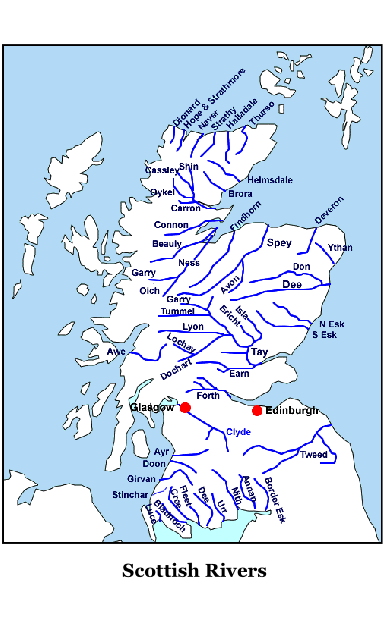 Nearly 120 miles long, the Tay runs from Loch Tay through the Highlands to its mouth at the Firth of Tay. Grilse, salmon, brown and sea trout are all taken from this most famous of rivers.
Nearly 120 miles long, the Tay runs from Loch Tay through the Highlands to its mouth at the Firth of Tay. Grilse, salmon, brown and sea trout are all taken from this most famous of rivers.
THE TWEED
Nearly one hundred miles long, this river straddles England and Scotland for part of its length. It flows east through southeast Scotland and then northeast England before entering the North Sea at Berwick. Considered the most prolific of all the salmon rivers, it produces fine catches of salmon, grilse and sea trout as well as wild and stocked brown trout.
THE DEE
Nearly ninety miles long, this river runs past the Queen's residence at Balmoral. Rising in the Cairngorms, it flows east to the North Sea. It produces fine numbers of salmon, grilse and sea trout.
THE SPEY
Nearly 110 miles long, it runs through the Grampian Mountains to the Moray Firth. It gives its name to the particular type of casting technique developed to overcome the handicap of limited room for back casting. It is a fast flowing river with some large tributaries which are noted salmon rivers in their own name, such as the Avon and the Dulnain. High averages of salmon and grilse are taken each year.
NORTH AMERICA
Fishing for the Pacific varieties can be somewhat different. Because the rivers tend to be much bigger there is less need for the salmon to wait for a rise in the river level before starting their run. In consequence the runs tend to be more spread out, each high tide bringing another flush of fish, which means that an angler has a better chance of bagging a prize.
The fishing techniques are somewhat different too. There is a good deal of evidence that salmon will eat their own eggs, even though they cannot digest them. This is probably a defence mechanism to avoid other fish species eating them. It is not unusual to see large trout patrolling the river beds where salmon are spawning in search of any eggs that have been dislodged by the spawning activity. Armed with this piece of information it is possible to use a fly that emulates a few salmon eggs bouncing down the river bottom. David Camiss shows how to make such a fly in this video.
Years ago it was the practice to find a spawning salmon in the shallows and strip the eggs out of her. They would then be tied into small bunches using a fine mesh bag. This bag of eggs was then snagged onto a bare hook and bounced down the river bottom with a weighted line or a normal fishing set-up and small weight. It is now considered unacceptable to use real eggs in most places and they have been replaced by pieces of foam, floss or any other suitable material tied into the shape of a few eggs. A bright red or orange material will fit the bill. Some even use a fish oil to give their artificial eggs the right taste!
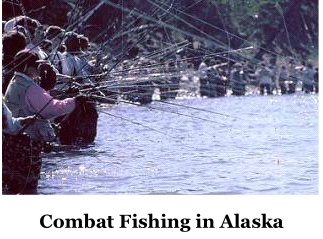 There are some areas of the rivers around Anchorage in Alaska that present you with their own form of angling called "combat fishing"! The sportsmen are packed so closely together that they literally fight to get their line in the water. That's not what you travelled half way round the world for! But take a float plane or boat to one of the outlying areas - or travel into the islands - and you will find places where you may still be the only rod on the water. If you think I’m exaggerating take a look at this video from New York State!
There are some areas of the rivers around Anchorage in Alaska that present you with their own form of angling called "combat fishing"! The sportsmen are packed so closely together that they literally fight to get their line in the water. That's not what you travelled half way round the world for! But take a float plane or boat to one of the outlying areas - or travel into the islands - and you will find places where you may still be the only rod on the water. If you think I’m exaggerating take a look at this video from New York State!
I have been privileged to fish several parts of Alaska as well as parts of Northern British Columbia. I can only say - if you get the chance then grab it with both hands! Where else can you catch a fifty pound king salmon in the morning then go a little way off shore and catch a two hundred and fifty pound halibut in the afternoon? Those are memories that you cherish forever.
In the big glacial rivers of the Pacific Northwest and in Alaska the same philosophy of goading the fish into taking the fly applies. In many rivers this is done from a boat rather from the bank. This gives the angler much greater access to the river. The guide runs the boat stationary against the current, holding it at a particular point in relation to the bank. The angler casts towards the bank and the guide then slips the engine into neutral, allowing the boat to move down river with the current. The object of this exercise is to give the angler's sink tip line sufficient time to submerge to a reasonable depth, as these rivers tend to be much deeper than their European cousins.
The guide then puts the boat's engine back into drive to hold the boat against the current again. The line and fly are taken further down river to end up behind the boat. Takes usually come as the fly changes direction and sweeps round in the current. The line is then retrieved and the process started again. This technique gives the opportunity to move down the river and explore all the holding points that would not be accessible from the bank.
The flies used are heavily weighted, garishly coloured, often with metal eyes and a lead body to add to the weight. The set up is so massive that it is not possible to simply lift the line from the water at the end of the retrieve. Several false roll casts are necessary to prepare the line for re-casting across the river. There isn't room on the boat to execute a Spey cast, so several roll cast are the order of the day. Takes are violent when they come and fights are monumental. A thirty or forty pound salmon can fight for over an hour and will be a memory to last the rest of your days.
Occasionally the fish are so numerous in salmon runs that it is almost impossible not to catch fish! This is especially true of the smaller salmon species, such as the chum and pink. I recall one occasion when we cast bare hooks across the river while wading. There were so many fish moving that the line would inevitably pass across an open mouth and the hook would obligingly take hold. Not exactly fly fishing, but exhilarating nevertheless! And while you are enjoying this embarrassment of riches don't forget to keep an eye out for others interested in the fish. You can be sure a bear or two is not far away!
BACK TO TOP
TABLE OF CONTENTS
